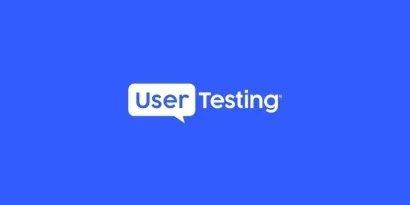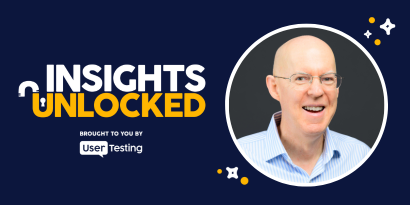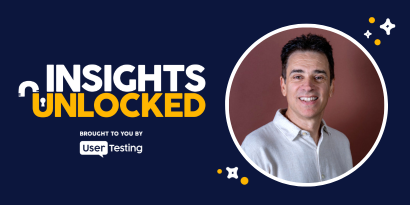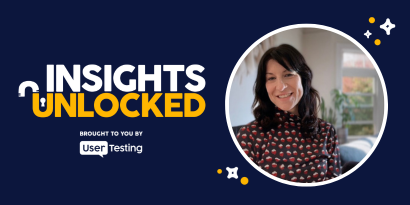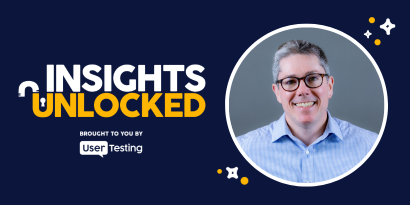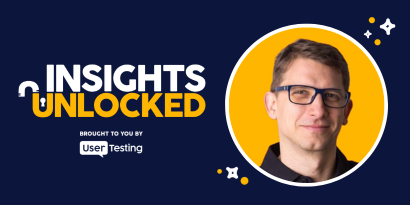
Episode 36 | March 21, 2022
Design thinking and innovation with Ian Roberts of IDEO
Discover how design thinking and customer-centric innovation drive business growth in this episode with Ian Roberts, COO at IDEO.
You can’t design the future in an Excel spreadsheet
What if your company’s most important strategic asset isn’t hidden in your analytics dashboard—but in the lives of your customers?
That’s the bold idea Ian Roberts, Chief Operating Officer at IDEO, brings to the table in a compelling conversation on Insights Unlocked. In a world increasingly obsessed with data, Roberts argues that true innovation starts not with metrics, but with empathy.
Here’s why embracing design thinking and customer-centric innovation could be the key to future-proofing your organization.
Why the past can't predict the future
“You can't design the future in an Excel spreadsheet,” Roberts says. “All that an Excel spreadsheet defines for you is the data that you've accrued on how things have worked in the past.”
It’s a wake-up call for organizations stuck in a loop of historical data and legacy metrics. As Roberts points out, companies are aging out of the Fortune 500 faster than ever before because they’re clinging to outdated business models. The world is changing too quickly for yesterday’s insights to guide tomorrow’s decisions.
To build future-fit organizations, leaders must look beyond spreadsheets and dashboards and into the real lives of their customers. That’s where human-centered design and ethnographic research come in.
“The past doesn’t predict how that plays out.” — Ian Roberts
What is design thinking and why does it matter?
Design thinking isn’t a buzzword—it’s a mindset. At its core, it’s about solving problems by balancing three crucial dimensions:
- Desirability: What do people need and want?
- Feasibility: What’s technically possible?
- Viability: What makes business sense?
IDEO, a global leader in human insights and product development, has long been a pioneer in this space. But as Roberts explains, it’s not about a rigid process—it’s about having the right toolkit and knowing when to use it.
“You can’t just copy and paste a process,” he says. “Designers have a toolkit and they lean on different methodologies depending on the problem they're trying to solve.”
This flexible, problem-first approach empowers cross-functional teams—marketers, technologists, strategists—to co-create better solutions for customers.
ON-DEMAND WEBINAR
Continuous discovery: transform your product development process
Seeing through the customer’s eyes
Roberts believes the most transformative innovations happen when companies stop designing for customers and start designing with them.
Before tools like UserTesting existed, understanding customers often fell to the marketing department. Today, it’s clear: serving the customer is everyone’s job.
And to truly understand customers, you can’t just ask them what they want. You have to immerse yourself in their lived experience.
“We want to understand people’s lived experience. That’s where the insight is.”
Through ethnographic research—watching and listening to people in their natural environment—IDEO uncovers insights that go far beyond what surveys and focus groups can reveal. These observations inspire empathy and lead to better products, services, and strategies.
Innovation isn’t about having better ideas
One of the biggest myths in business? That companies struggle because they lack good ideas.
“The problem isn’t having new ideas,” Roberts says. “It’s identifying which of the ideas you already have best serve your customers—and then clearing the path for those ideas to flourish.”
He describes a common IDEO strategy called a beacon project: a sponsored initiative where a team is empowered to work differently, free from the constraints of conventional processes. These cross-disciplinary teams—made up of marketers, engineers, and researchers—use participatory design and customer empathy to reframe problems and uncover transformative solutions.
Research isn’t the end of the process—it’s the beginning
A critical shift in thinking? Seeing customer research not as a validation tool, but as a driver of strategy.
“Research has a role to play throughout the lifecycle of any organization,” Roberts explains. “It’s one of the most strategic levers a senior executive can use.”
At companies like Ford, where Roberts collaborated with leaders during a major transformation, research wasn’t an afterthought—it shaped corporate strategy. The Ford team reconnected with real customers to guide decisions that ultimately led to more agile operations and market success.
Roberts shares a powerful example: convincing traditional F-150 customers that an electric truck could still be “Ford tough.”
“You don’t lead with ‘Do you want an electric truck?’” he explains. “You lead with, ‘Would you like to power your tools from the back of your truck?’”
“You have to prototype that future and test it to make smarter strategic decisions.”
Building a participatory future
The future of customer feedback is moving beyond simple surveys. It’s becoming more participatory, more inclusive, and more representative.
“We’re reaching a point where design is shifting from ‘we design for you’ to ‘we design with you,’” Roberts says. “That’s a radically different relationship.”
To make this shift, companies must broaden their feedback loops. Listening only to “power users” or loyal segments creates a feedback echo chamber. Instead, brands must reach new audiences and intentionally build diversity and representation into their research practices.
Roberts predicts that brands will soon need to answer tough questions like: Is our research extractive or collaborative? Are we creating value for the community or just for our company?
Data is valuable—but limited
Of course, big data still plays a role. But Roberts emphasizes that numbers alone aren’t enough.
“Even though only 23% of initiatives driven by big data alone turn a profit, many leaders still don’t realize what they’re missing,” he notes.
Data tells you what happened. Human insights reveal the why.
That’s why tools like UserTesting—which enable organizations to gather real-time, qualitative feedback from users—are so vital. They help build organizational intuition: a pattern-matching ability grounded in empathy and experience.
Three steps to becoming more customer-centric
Want to start shifting your organization toward a customer-centric innovation model? Here’s a simplified roadmap:
- Create a protected space for experimentation
Launch a beacon project where teams are empowered to work differently with executive sponsorship. - Make research interdisciplinary
Bring marketers, engineers, strategists, and designers together to analyze and act on insights. - Engage customers as collaborators
Move from extractive research to participatory design. Involve customers in identifying problems and shaping solutions.
Final thoughts: empathy is your edge
In a world that’s racing toward automation, the human touch is your competitive advantage. Design thinking is more than a methodology—it’s a way to make sure your business stays relevant, innovative, and connected to the people it serves.
As Roberts puts it:
“The only place to start is asking: what is the role of your brand in the lives of your customers?”
When you begin with empathy, you end with impact.
